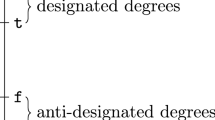Abstract
The paper examines ways in which the interpretation of spatial concepts is affected by vagueness and suggests mechanisms for taking account of this within spatial information systems. The theory of supervaluation semantics is explained and applied to the spatial domain and to particular problems of defining geographical concepts such as ‘forest’.
This work was supported by the EPSRC under grant GR/M56807.
Access this chapter
Tax calculation will be finalised at checkout
Purchases are for personal use only
Preview
Unable to display preview. Download preview PDF.
Similar content being viewed by others
References
Alker, S., Joy, V., Roberts, P. and Smith, N.: 2000, The definition of brownfield, Journal of Environmental Planning and Management 43(1), 49–69.
Bennett, B.: 1998, Modal semantics for knowledge bases dealing with vague concepts, in A. G. Cohn, L. Schubert and S. Shapiro (eds), Principles of Knowledge Representation and Reasoning: Proceedings of the 6th International Conference (KR-98), Morgan Kaufman, pp. 234–244.
Bennett, B.: 2001, What is a forest? on the vagueness of certain geographic concepts, Topoi 20(2).
Burrough, P. and Frank, A. (eds): 1996, Geographical Objects with Undetermined Boundaries, GISDATA, Taylor and Francis.
Calvanese, D., Lenzerini, M. and Nardi, D.: 1998, Description logics for conceptual data modelling, in J. Chomicki and G. Saake (eds), Logics for Databases and Information Systems, Kluwer, chapter 1.
Cohn, A. G. and Gotts, N. M.: 1996a, The ‘egg-yolk’ representation of regions with indeterminate boundaries, in P. Burrough and A. M. Frank (eds), Proceedings, GISDATA Specialist Meeting on Geographical Objects with Undetermined Boundaries, Francis Taylor, pp. 171–187.
Cohn, A. G. and Gotts, N. M.: 1996b, Representing spatial vagueness: a mereological approach, in J. D. L C Aiello and S. Shapiro (eds), Proceedings of the 5th conference on principles of knowledge representation and reasoning (KR-96), Morgan Kaufmann, pp. 230–241.
Eschenbach, C.: 2000, Ontology, predicates and identity, in S. Winter (ed.), Geographical Domain and Geographical Information Systems, Vol. 19 of Geoinfo, Institute for Geoinformation, Vienna University of Technology, pp. 33–36.
Evans, M.: 1978, Can there be vague objects?, Analysis 38, 208. reprinted in his Collected Papers, Oxford, Clarendon Press 1985.
Fine, K.: 1975, Vagueness, truth and logic, Synthèse 30, 263–300.
Frank, A.: 1997, Spatial ontology: a geographical information point of view, in O. Stock (ed.), Spatial and Temporal Reasoning, Kluwer, Dordrecht, chapter 5, pp. 321–352.
Goodchild, M. F.: 1993, Data models and data quality: problems and prospects, in M. F. Goodchild, B. O. Parks and L. T. Steyaert (eds), Visualization in Geographical Information Systems, John Wiley, New York, pp. 141–149.
Goodchild, M. F. and Gopal, S. (eds): 1989, Accuracy of Spatial Databases, Taylor and Francis, London.
Heuvelink, G. B.: 1998, Error Propagation in Environmental Modelling with GIS, Taylor and Francis.
Hughes, C.: 1986, Is a thing just the sum of its parts?, Proceedings of the Aristotelian Society 86, 213–233.
Husch, B., Miller, C. and Beers, T.: 1963, Forest Mensuration, Wiley. 3rd edition 1982.
Johnston, D. and Lowell, K.: 2000, Forest volume relative to cartographic broundaries and sample spacing, unit size and type, Geographical and Environmental Modelling 4(1), 105–120.
Kulik, L.: 2000, Vague spatial resoning based on supervaluation, in S. Winter (ed.), Geographical Domain and Geographical Information Systems, Vol. 19 of Geoinfo, Institute for Geoinformation, Vienna University of Technology, pp. 73–80.
Lehmann, F. and Cohn, A. G.: 1994, The EGG/YOLK reliability hierarchy: Semantic data integration using sorts with prototypes, Proc. Conf. on Information Knowledge Management, ACM Press, pp. 272–279.
Maling, D.: 1989, Measurements from Maps: principles and methods of cartometry, Pergamon Press.
Mark, D. and Csillag, F.: 1989, The nature of boundaries on ‘area-class’ maps, Cartographica 26, 65–78.
McCarthy, J.: 1993, Notes on formalizing context, Proceedings of the thirteenth international joint conference on artificial intelligence (IJCAI-93).
McGee, V.: 1997, Kilimanjaro, Canadian Journal of Philosophy pp. 141–195. supplementary volume 23.
Ordnance Survey: 2000, Land-Line User Guide v3.0. http://www.os.co.uk/downloads/vector/landline/Lline_w.pdf.
OrMlowska, E. (ed.): 1997, Incomplete Information–rough set analysis, Physica-Verlag, Heidelberg.
Smith, B.: 1995, On drawing lines on a map, in A. Frank and W. Kuhn (eds), Spatial Information Theory–Proceedings of COSIT’95, number 988 in Lecture Notes in Computer Science, Springer, Berlin, pp. 475–484.
UNESCO: 1973, International classi.cation and mapping of vegetation, A report of the United Nations Educational, Scientific and Cultural Organization (UNESCO), Series 6, Ecology and Conservation.
USGS: 1994a, Field Methods for Vegetation Mapping, United States Geological Survey, NPS Vegetation Mapping Program. http://biology.usgs.gov/npsveg/fieldmethods/index.html.
USGS: 1994b, Standardized National Vegetation Classification System, United States Geological Survey, NPS Vegetation Mapping Program. http://biology.usgs.gov/npsveg/classification/index.html.
Vckovski, A.: 1997, Interoperability and spatial information theory, Proceedings of Interop97, International Conference on Interoperating Information Systems.
Wang, F. and Brent Hall, G.: 1996, Fuzzy representation of geographical boundaries in GIS, International Journal of GIS 10(5), 573–590.
Williamson, T.: 1994, Vagueness, The problems of philosophy, Routledge, London.
Zadeh, L. A.: 1975, Fuzzy logic and approximate reasoning, Synthese 30, 407–428.
Author information
Authors and Affiliations
Editor information
Editors and Affiliations
Rights and permissions
Copyright information
© 2001 Springer-Verlag Berlin Heidelberg
About this paper
Cite this paper
Bennett, B. (2001). Application of Supervaluation Semantics to Vaguely Defined Spatial Concepts. In: Montello, D.R. (eds) Spatial Information Theory. COSIT 2001. Lecture Notes in Computer Science, vol 2205. Springer, Berlin, Heidelberg. https://doi.org/10.1007/3-540-45424-1_8
Download citation
DOI: https://doi.org/10.1007/3-540-45424-1_8
Published:
Publisher Name: Springer, Berlin, Heidelberg
Print ISBN: 978-3-540-42613-4
Online ISBN: 978-3-540-45424-3
eBook Packages: Springer Book Archive




